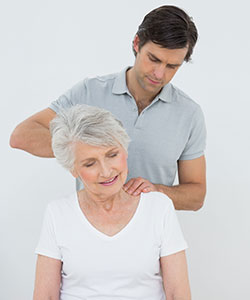Patient Education: Cervical Stenosis / Radiculopathy

As we age, the gradual degeneration of the spine can be a source of neck pain, and may eventually result in a condition called cervical stenosis. When a nerve is compressed, and pain, tingling, or numbness shoots down the arm, it is called cervical radiculopathy. The cervical spine refers to the portion of the spinal column located in the neck, made up of the seven vertebrae between the head and the chest.
The spinal cord is protected by a bony tube in the spinal column. Certain conditions can narrow the space in the tube, squeezing the nerves of the spinal cord. This is called stenosis. Several factors can cause cervical stenosis, but with proper treatment, you can find relief from this condition.
Causes and Symptoms
Age is the main contributor to cervical stenosis; it is most prevalent in those over the age of 50. As we get older, the size and shape of the spinal canal may change. Disks lose water content over time, and may begin to collapse, losing some of their shock-absorbing ability. The tissues covering the bones of the spinal column may deteriorate; the disks between the bones may begin to bulge; or the tissues connecting the bones may begin to thicken with inflammation. Bone spurs may eventually develop as the tissue deteriorates, which can also cause narrowing of the spinal column.
This narrowing of the spinal column can put pressure on the nerves in the cervical spine, causing numbness, pain, or tingling, particularly in the hands and arms. You may also experience pain or stiffness in the neck, and weakness in your extremities.
Treatment
Depending on the severity of your condition, cervical stenosis can be treated with or without surgery. Your doctor will first perform a physical exam to ensure a correct diagnosis. This exam may involve checking the range of movement in the neck, checking for tenderness or muscle spasms, and testing your reflexes. Additionally, X-rays are often used to check for damage in the spinal bones, while an MRI can help to show damage to the soft tissue, such as the intervertebral disks.
Generally, your doctor will try to treat your symptoms without surgery first. Nonsurgical treatment may involve over-the-counter medications like NSAIDs. Your doctor might also prescribe muscle relaxers to help with spasms, or administer a corticosteroid injection to help reduce inflammation and relieve pressure on the spinal column. You may work with a physical therapist to learn exercises that can help to build up strength and endurance, maintain flexibility of the spine, and improve your balance. You can use a heating pad or ice pack to help ease symptoms as well.
If more conservative methods are not working for you, or your condition has progressed to the point that you cannot function properly, interventional pain management or surgical treatment may be an option. Interventional pain management (epidural injections or pain blocks) consists of cortisone shots that can reduce inflammation and reduce pain effectively. The goal of surgery is to relieve pressure on the spinal cord and regain alignment and strength of the spine. To achieve this, your surgeon may trim, remove, or adjust the diseased parts that are causing the pressure or misalignment.
The common surgeries performed for cervical stenosis are anterior cervical discectomy and fusion (ACDF), artificial disc replacement, and decompressive laminectomy. It involves removing the disc and/or bone that compresses the nerves to create more space. Surgery may be approached from either the front or back of the neck, depending on the type of procedure.
With surgical intervention, patients may experience significant improvement in sensation and function of the extremities. However, the primary function of surgery is to relieve pain and prevent further damage. Cervical stenosis and radiculopathy, if left untreated, can result in severe disability over time.
Cervical Stenosis/Radiculopathy Treatment in Miami
Dr. Amar Rajadhyaksha of Miami Spine Institute is a board-certified and fellowship-trained orthopaedic spinal surgeon who specializes in minimally invasive surgical techniques. If you have any questions for Dr. Rajadhyaksha, or would like to schedule an appointment, please feel free to contact his office.
